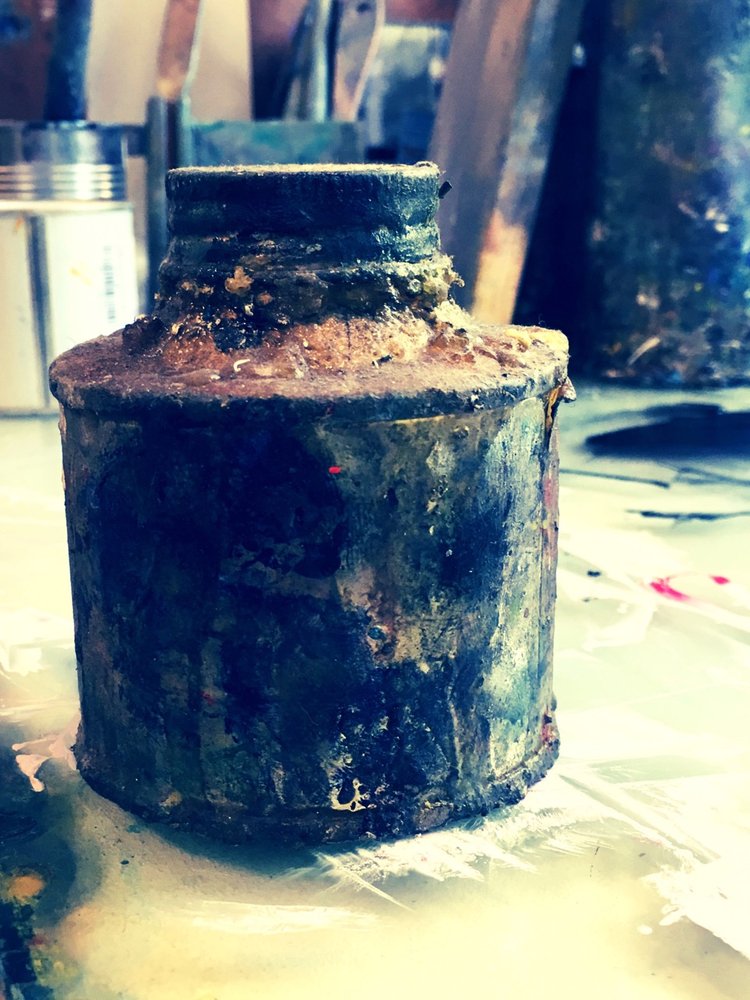Solid Air No. 12
Notes on my practice (manifesto)
by
Jonathan S Hooper
June 2018
“There must be a painting totally free of dependence on the figure-or object-which, like music, illustrates nothing, tells no story, and launches no myth. Such a painting would simply evoke the incommunicable kingdoms of the spirit, where dreams become thought, where line becomes existence” : Michel Seuphor (1901- 1999)
Art is a form of dialogue and painting has a particular role to play in this. Dialogue should be an active engagement and not a passive “echo chamber” process. As such it should perhaps aspire to both inform and transform.
Paint, like words, can be used as a signifier in a semiological sense. Unlike language however, paint can be free from the prescriptive, more formal constraints and prejudices that can attach to words. Not just through its colour but also through its sheer materiality paint can invoke a sensory response loaded with highly personal associations; “the incommunicable kingdoms of the soul” [see Seuphor above].
The ambiguity of abstract paintings in particular can work on the imagination in ways that are often beyond description.
In this sense perhaps paint and paintings can appeal to ideas of postmodernist fragmentation; a general distrust of theories and the rejection of grand narrative; an attempt to overcome innate or “smuggled-in” bias. Paintings can then set up an invitation for the viewer to imagine without any imposed structure or expectation.
For me painting is about process.
It is a collaboration between ideas and technique on the one hand with the deterministic qualities of paint on the other. Working with the paint rather than simply trying to control it; accepting chance and mistake and co-opting these tendencies into the final work. In this regard mistakes can be viewed as starting points and the impetus towards improvisation and invention.
Landscape is my preferred subject matter, although I largely reject direct representation.
Landscape is of course the matrix in which all of human experience and consciousness is played out. As such it is not 2-dimensional, or even 3-dimensional, but operates in multi-dimensional space. Landscape paintings, in my terms, become complexity maps, the defining coordinates of which are the observable and describable combined with the experiential and the metaphysical; the sensed combined with the remembered or imagined.
I take a small and increasingly familiar part of North Cornwall as my starting point in this,
using ever more fugitive ideas of form as the foundations on which the painting is built up. I regard painting as path-finding rather than navigation. That is to say, the starting point is known but the destination or end point is only revealed on arrival. Put another way the painting’s conclusion is not consciously predetermined; it is more about acceptance than ambition and might perhaps be considered a rebuke to ego.
Repetition is of increasing interest and importance in my pursuits.
Not repetition in the form of the unerring multiples of digital mass-production but repetition that is both empowered by chance and susceptible to nuance. Through this type of repetition we can perhaps get closer to the essential qualities of thing or place and therefore more closely connect with experience. With repetition the immediately obvious fades into background allowing the small, otherwise unnoticed details to stake their claim.
My paintings have spatial, sensory and time-based elements.
These coordinates are revealed in informal, deconstructed grids and the vectors- or pathways- that traverse and bisect them; multiple views of the same experiential space inter-woven and over-layed, with time as the variable. The physical structure of the paint also has a particular roll to play creating its own additional dimension or axis.
It is my view that Art inhabits the space between the clamouring, inquisitive “why?” and the indifferent, universal “Is”.
Whether Art should join Science in seeking to bridge this divide is, for me, still moot. Perhaps the power of Art lies in its permission to revel in inhibition and imagination; its freedom from hard and fast rules; its freedom from any imperatives to follow prescribed methodologies.Consequently, I see the position of the Artist to be that of standing at the edge looking out.
-//-

